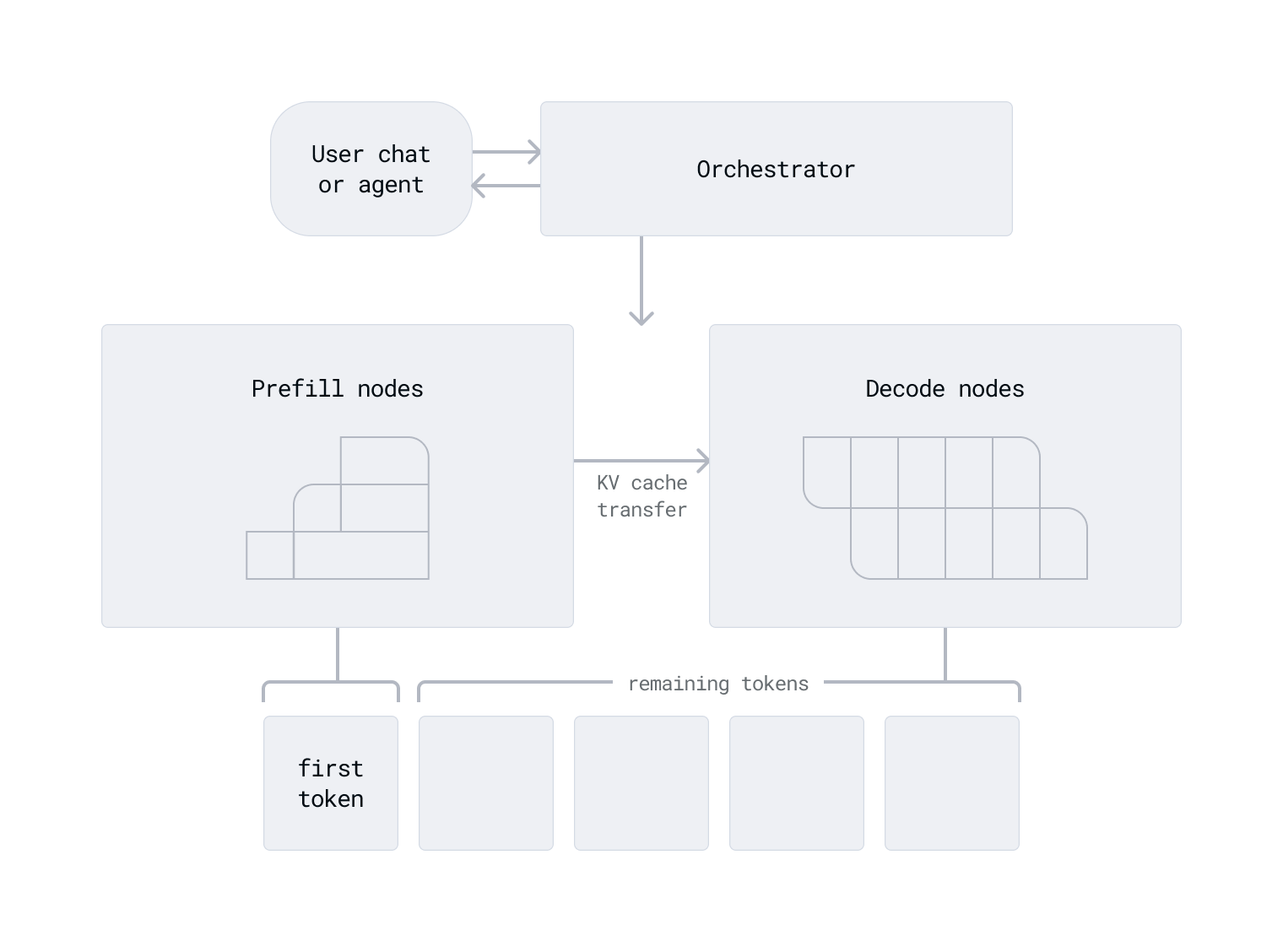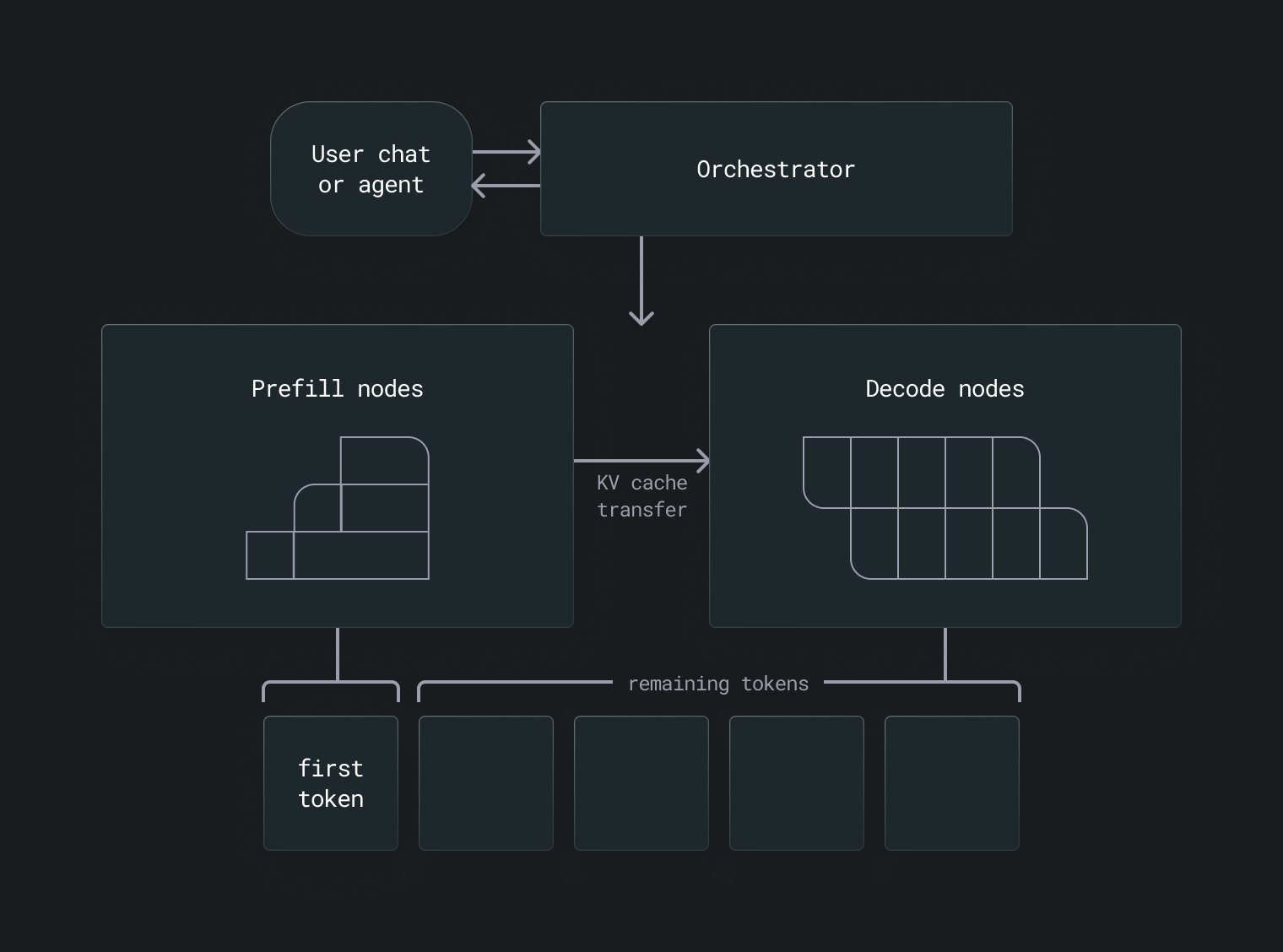Disaggregated inference
Disaggregated inference is a serving architecture pattern designed for large language models (LLMs), particularly decoder-only transformer models like those in the LLaMA or GPT model families. In decoder-only transformers, the process of generating model output is divided into two distinct phases: prefill and decode.
With disaggregated inference, these phases are executed on different hardware resources. You might see this technique referred to by several names, including disaggregated inference, disaggregated prefill, or disaggregated serving. All of these describe the same core idea: separating the model's inference phases and providing each phase with dedicated resources optimized to improve performance and scalability.
When to use disaggregated inference
Disaggregated inference is particularly valuable if your priority is minimizing latency. Since the prefill stage is compute-intensive and the decode stage is more memory-bound, isolating the two stages and allocating them to different GPUs or GPU nodes reduces resource contention and helps achieve both faster time-to-first-token and smoother token streaming.
Because disaggregated inference gives you separate levers to manage the prefill and decode phases independently, it is especially effective for improving tail latency, such as P95, which measures how long it takes to complete 95% of requests. By optimizing tail latency, you reduce delays for the slowest requests and can improve overall responsiveness.
Disaggregation itself doesn't directly increase throughput, but it enables more granular parallelism strategies and resource allocation, which can increase processing capacity. This flexibility allows you to optimize each phase appropriately and scale prefill and decode nodes independently as needed, improving GPU utilization and overall efficiency without over-provisioning capacity just to handle peak workloads.
Additionally, disaggregated inference offers flexibility in heterogeneous or resource-constrained environments. You can match each phase with hardware that suits its specific demands.
How disaggregated inference works
LLM inference involves two distinct phases known as prefill and decode, each with unique performance characteristics that affect how systems should allocate and optimize resources.


Prefill, also known as context encoding, is the initial phase where the model processes the entire input prompt. During this phase, the model performs a full forward pass to initialize its key-value (KV) cache and predict the first output token. This cache stores the intermediate attention states necessary for generating subsequent tokens. The prefill phase is compute-intensive, especially in the case of long user prompts, as it involves large-scale matrix operations that demand high floating-point throughput. The metric associated with this phase is often referred to as Time-to-First-Token (TTFT), indicating the duration from receiving the input prompt to producing the first output token.
Following prefill, the model enters the decode phase, or token generation. In this phase, the model generates output tokens one at a time, using the KV cache initialized during prefill. By leveraging this cache, the model can quickly access previously computed information without reprocessing the full input each time. As a result, the decoding phase is less compute-intensive per token but becomes memory-bound, relying heavily on efficient access to the cached data. The key performance metric here is Inter-Token Latency (ITL), which measures the time taken to generate each subsequent token after the first.
Disaggregated inference involves separating these two phases onto different GPUs or GPU nodes. By doing so, each phase can be optimized independently. Prefill workloads can be routed to hardware with high compute throughput to handle the intensive matrix operations required to process long input prompts. Meanwhile, decode workloads can be assigned to hardware with fast memory access, which are better suited for the sequential, cache-dependent nature of token generation. This separation reduces contention between compute-bound and memory-bound tasks, improves resource utilization, and allows for more scalable and predictable inference performance.
Become a design partner
If you're exploring disaggregated inference for your deployments, start by analyzing your workload to spot any imbalances between prompt processing and token generation. Check whether your GPUs are underutilized during either phase. If you're encountering these challenges, feel free to reach out to talk to an AI expert.
Get the latest updates
Stay up to date with announcements and releases. We're moving fast over here.
Talk to an AI Expert
Connect with our product experts to explore how we can help you deploy and serve AI models with high performance, scalability, and cost-efficiency.
Was this page helpful?
Thank you! We'll create more content like this.
Thank you for helping us improve!
